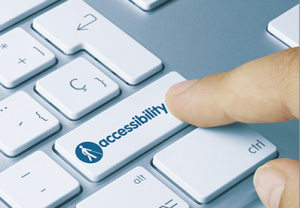We all know public areas such as office buildings and supermarkets are legally required to be accessible by people with disabilities. Ramps for wheelchairs, braille for any informational signage (such as elevator floor buttons) and other additional features are required by law. Of course this is the case. We can’t expect someone who can’t walk not be able to get through a grocery store. But the ADA website compliance requirements were created long before the Internet was used by nearly every human on the planet so…
 What about Disability Accessibility Requirements for Websites?
What about Disability Accessibility Requirements for Websites?
Legally, the U.S. DOJ (Department of Justice) uses the WCAG 2.0 AA guidelines as a reference. This is a list of criteria to determine if a website is appropriately accessible to people who have limited vision or hearing. Our ADA Website Consultants can make your site 100% ADA compliant based on WCAG rules and standards. FYI – WCAG is pronounced WahCahG…
There are nearly 40 requirements websites must adhere to in order to be ADA complaint. Geeze! That’s a lot.
Where to Start with Website ADA Compliance?
After reading the WCAG 2.0 requirements and descriptions you’ll likely have a headache and not be much more knowledgeable than before you started. Let’s break these requirements down into bite size chunks. The WCAG guidelines are broken down into four main sections:
- Perceivable – Information (text, images, video, etc) is easily available to everyone regardless of accessibility needs.
- Operable – Website interfaces do not require interaction that can not be performed by anyone.
- Understandable – Instructions can be understood by everyone (such as an error message indicating an email address is not in the proper format)
- Robust – Your website is accessible through a variety of interfaces and user agents (screen readers, interactive braille, etc)
Now that we understand the basic, general requirements, let’s dig into specifics (note this is not a full list, but is a great starting point):
ADA Compliance Guideline: Perceivable
If you can see and hear correctly there are hundreds of aspects of the world you take for granted. Take for example photos. If you want to buy something form a website you look at the name description and photo(s). What if you can’t see? The website needs to tell the user what the image is in concise yet descriptive terms. What about an educational video? If you can’t hear you’ll need clear captions and/or a transcript to tell you what you need to know.
The first and easiest thing to change about your website for compliance is add ALT tags to all images. This is easy enough but if you have a huge site with thousands of images it could be a daunting process. Start with the global images that are in your header and footer and work your way through starting with the most visited pages of your site.
Then, if you have video, add audio descriptions. Ugh! WCAG states all non-audible information presented on a video must have corresponding audio. Fortunately the WCAG is not the law and in certain cases a lawyer can argue a way out of this one until you can get your site fully compliant.
Then add transcripts to all audio and video content. There are many programs that will do this for you. All you have to do is proof read and correct as needed.
Then get rid of images of text. Images can’t be read by screen readers so a blind user of your website will be at a loss if text is conveyed in images.
ADA Compliance Guideline: Operable
The big one here is your website has to be navigable with a keyboard only. That typically means using the TAB or arrow keys to go from section to section in an orderly, um, order including navigation.
You also should add the ability for a user to skip your navigation just like a non-disabled user could. A screen reader will literally tab through every link in your navigation every time a new web page is loaded and you don’t want your disabled visitors to deal with that. Let them click a link to a page, let’s say “contact us” and be able to get straight to your email form or contact information.
ADA Compliance Guideline: Understandable
Start with Title Tags (Different than the headings) – Make the title of your pages clear and understandable if read aloud.
Make your navigation consistent from page to page. This is usually a default of most websites, but some have a different blog site that may use varying navigation.
Make forms easy to understand to users who can not see (aria labels are key here)
Contrast – text, links and other aspects of your site need to have appropriate contrast between the fore and background.
Remove any time constraints. This is uncommon but if a page auto loads another page or changes in any way automatically there must be a way to prevent this that is understandable to all users.
ADA Compliance Guideline: Robust
Make sure your site can be zoomed in at least 200% without loss of usability.
Ensure users who use screen readers and other assistive technology can read/hear the content of your site in an orderly fashion.
Note: This is not a comprehensive list of requirements. Please see the WCAG link above for full details on web accessibility
How to Get ADA Compliant
Start with a website ADA audit. We’re more than happy to run a preliminary audit for free so you know what the issues are. Of course we can give you a quote for detailed recommendations and making corrections.
